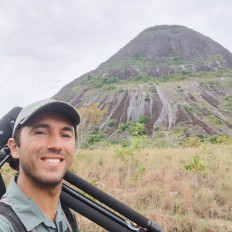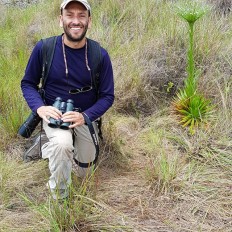Top species
- Sword-billed Hummingbird (Ensifera ensifera)
- Black-and-chestnut Eagle (Spizaetus isidori)
- Black-billed Mountain-Toucan (Andigena nigrirostris)
- Yellow-eared Parrot (Ognorhynchus icterotis)
- Chestnut-naped Antpitta (Grallaria nuchalis)
- Chami Antpitta (Grallaria alvarezi)
- Ocellated Tapaculo (Acropternis orthonyx)
- Flammulated Treehunter (Thripadectes flammulatus)
- Chestnut-crested Cotinga (Ampelion rufaxilla)
- Munchique Wood-Wren (Henicorhina negreti)
- Tanager Finch (Oreothraupis arremonops)
- Yellow-headed Brushfinch (Atlapetes flaviceps)
- Red-bellied Grackle (Hypopyrrhus pyrohypogaster)
- Golden-fronted Redstart (Myioborus ornatus)
- Hooded Mountain Tanager (Buthraupis montana)
- Purplish-mantled Tanager (Iridosornis porphyrocephalus)
List up to ca. 25 species that:
• have a limited distribution range and/or are rare on a global level
• are most sought-after by birdwatchers at this site
• and are relatively easy to see at this site (year-round or seasonally)
| Sword-billed Hummingbird (Ensifera ensifera) | |
| Black-and-chestnut Eagle (Spizaetus isidori) | |
| Black-billed Mountain-Toucan (Andigena nigrirostris) | |
| Yellow-eared Parrot (Ognorhynchus icterotis) | |
| Chestnut-naped Antpitta (Grallaria nuchalis) | |
| Chami Antpitta (Grallaria alvarezi) | |
| Ocellated Tapaculo (Acropternis orthonyx) | |
| Flammulated Treehunter (Thripadectes flammulatus) | |
| Chestnut-crested Cotinga (Ampelion rufaxilla) | |
| Munchique Wood-Wren (Henicorhina negreti) | |
| Tanager Finch (Oreothraupis arremonops) | |
| Yellow-headed Brushfinch (Atlapetes flaviceps) | |
| Red-bellied Grackle (Hypopyrrhus pyrohypogaster) | |
| Golden-fronted Redstart (Myioborus ornatus) | |
| Hooded Mountain Tanager (Buthraupis montana) | |
| Purplish-mantled Tanager (Iridosornis porphyrocephalus) |
Yellow-headed Brushfinch (Atlapetes flaviceps) was added by Mathias Ritschard (Admin) (2021-08-17 14:04:26)
Purplish-mantled Tanager (Iridosornis porphyrocephalus) was added by Mathias Ritschard (Admin) (2020-10-01 13:06:07)
Hooded Mountain Tanager (Buthraupis montana) was added by Mathias Ritschard (Admin) (2020-10-01 13:05:55)
Golden-fronted Redstart (Myioborus ornatus) was added by Mathias Ritschard (Admin) (2020-10-01 13:05:48)
Red-bellied Grackle (Hypopyrrhus pyrohypogaster) was added by Mathias Ritschard (Admin) (2020-10-01 13:05:34)
Tanager Finch (Oreothraupis arremonops) was added by Mathias Ritschard (Admin) (2020-10-01 13:05:27)
Munchique Wood-Wren (Henicorhina negreti) was added by Mathias Ritschard (Admin) (2020-10-01 13:05:16)
Chestnut-crested Cotinga (Ampelion rufaxilla) was added by Mathias Ritschard (Admin) (2020-10-01 13:05:04)
Flammulated Treehunter (Thripadectes flammulatus) was added by Mathias Ritschard (Admin) (2020-10-01 13:04:51)
Ocellated Tapaculo (Acropternis orthonyx) was added by Mathias Ritschard (Admin) (2020-10-01 13:04:44)
Chami Antpitta (Grallaria alvarezi) was added by Mathias Ritschard (Admin) (2020-10-01 13:04:33)
Chestnut-naped Antpitta (Grallaria nuchalis) was added by Mathias Ritschard (Admin) (2020-10-01 13:04:22)
Yellow-eared Parrot (Ognorhynchus icterotis) was added by Mathias Ritschard (Admin) (2020-10-01 13:04:15)
Black-billed Mountain-Toucan (Andigena nigrirostris) was added by Mathias Ritschard (Admin) (2020-10-01 13:03:57)
Black-and-chestnut Eagle (Spizaetus isidori) was added by Mathias Ritschard (Admin) (2020-10-01 13:03:48)
Sword-billed Hummingbird (Ensifera ensifera) was added by Mathias Ritschard (Admin) (2020-10-01 13:03:35)





